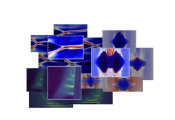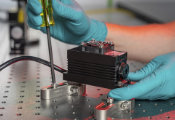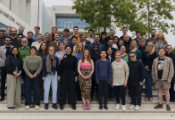USTC Develops Self-Locking Broadband Raman-Electro-Optic Microcomb
August 17, 2025 -- A team led by Prof. DONG Chunhua from the University of Science and Technology of China (USTC), in collaboration with Prof. BO Fang's group from Nankai University, has successfully developed a self-locked Raman-electro-optic (REO) microcomb on a single lithium niobate chip. By synergistically harnessing the electro-optic (EO), Kerr, and Raman effects within one microresonator, the team achieved a microcomb with a spectral width exceeding 300 nm and a repetition rate of 26.03 GHz, without the need for external electronic feedback. The research was published in the Nature Communications.
Optical frequency combs, light sources composed of equally spaced frequency lines, are essential tools in modern optical communications, precision measurement, and fundamental physics research. While traditional OFCs are typically based on bulky mode-locked lasers, recent advances in integrated photonics have enabled chip-scale Kerr and EO combs. However, these integrated solutions still face challenges in achieving broad spectral output and low-noise stability. In particular, parasitic nonlinear effects like Raman scattering, which often occur at high pump powers, can limit the performance of these microcombs.
In this work, the researchers proposed and demonstrated a novel mechanism for generating a self-locked broadband REO microcomb. Instead of treating Raman scattering as a limitation, they transformed it into a beneficial nonlinear process. The new mechanism leverages Raman scattering and EO modulation to generate multiple sets of EO combs, while four-wave mixing (FWM) further broadens the spectrum. Critically, the comb lines originating from the Raman laser self-adaptively phase-lock to the comb lines from the primary pump light, ensuring high coherence across the entire system without external intervention.
The resulting broadband REO microcomb, generated in a single lithium niobate racetrack microresonator, spans a spectral width of over 300 nm, containing more than 1400 individual comb lines at a repetition rate of 26.03 GHz. The system demonstrated high coherence and fast tunability, achieving phase-locking automatically. Additionally, the microcomb's repetition rate features a self-locking tuning range of approximately 550 kHz, which can be extended up to 8 MHz through thermal tuning induced by microwave power adjustments.
The work establishes an experimental platform for exploring complex multi-nonlinear physical processes on-chip, such as injection locking and self-synchronization. With its broad bandwidth and robust self-locking, the REO microcomb holds significant promise for applications in high-resolution spectroscopy, advanced optical communications, and quantum information processing.




































